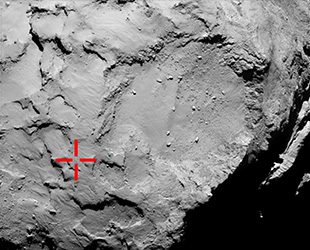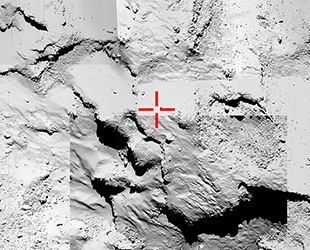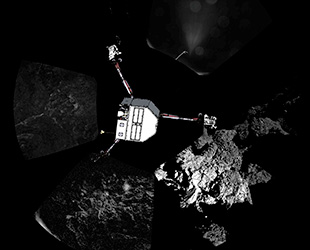Nov. 13, 2014 — The first space probe to touch down on the surface of a comet did so three times before it finally came to rest in the shadow of a cliff.
The European Space Agency (ESA) on Thursday (Nov 13) released photos captured by the Rosetta mission's Philae lander showing the three-legged probe was on the surface of Comet 67P/Churyumov-Gerasimenko. The probe, which on Wednesday separated from the Rosetta spacecraft and descended for seven hours to the comet's surface, did, in fact, land, but where exactly is still not known.
"We understood that we... bounced two times and finally stopped at a place we haven't entirely located," said Jean-Pierre Bibring, the Philae lander's lead scientist. "We sort of got close to the place that we are, where we think we are, which is not very close to [where] we wanted to [be], but not very far away."
Given the low gravity of the comet, Philae was equipped with a thruster to push its landing legs into the ground and with ice screws to hold it to the surface. The probe also had two harpoons to secure it in place. But none of those mechanisms worked.
Instead, Philae bounced.

Image showing the location where the Philae lander first touched down on Comet 67P, before bouncing twice. (ESA) |
"We know now the first jump was about two hours," said Stephan Ulamec, director of the Philae landing team at the German Aerospace Center. "A two hour jump probably up to 1 kilometer [0.6 miles] and probably also one kilometer distance and this makes it difficult to find out where we are now."
The probe's second rebound was shorter.
"We know very well where we touched down first," Ulamec said. "It was [then] a huge leap. And then we had another, small jump of about 3 centimeters per second [1.2 inches per second] for seven minutes."
Philae had been targeted to land and at first touched down in a clearing ESA referred to as "J" before holding a public contest to rename it "Angilika." Ulamec said that they now believe the probe bounced from that optimal landing site to an area located opposite a large crater at the head of the comet known only a "B."
"The interesting thing is [that] we did a lengthy landing site selection process, we were not sure about landing site 'J' or 'I' or 'B' [but] maybe we landed on all three of them," he said, referencing the three touch downs.

Composite image showing the believed location where the Philae lander finally settled on the surface of the comet. (ESA) |
Wherever it is that Philae ultimately settled down, it is in a precarious position, both physically and power-wise.
"We are just in the shadow of a cliff," Bibring stated, "and because of that we're in the shadow permanently, and that is part of the problem."
Upon landing, Philae had enough battery power to run its ten science instruments for 64 hours. After that, it was to rely on its solar panels to recharge.
In the shadow though, the probe doesn't receive as much sunlight as had been planned.
"We see that we get less solar power than we planned for at the nominal landing site," Koen Geurts, Philae technical manager at the lander control center in Cologne, said. "We are receiving about one and a half hours of sunlight with respect to the six or seven that we were aiming for."
"This, of course, has an impact our energy budget and our capabilities to conduct science for an extended period of time afterwards," Geurts explained. "We're calculating now what this means for the near future. Unfortunately this is not the situation we were hoping for."

Panoramic 360 degree view of the Philae lander's surroundings. Superimposed is a sketch of the spacecraft in the configuration the lander team currently believes it is in. (ESA) |
Further complicating matters is the orientation in which the probe finally landed. One of its legs appears from photos to be off the ground and without the harpoons securing the craft in place, it is possible it could move again. As such, the project's scientists are holding off using Philae's drill to collect samples.
"We're very hesitant or we have to be very careful [doing] any kind of mechanical actuation," Ulamec explained. "We are hesitant in the next hours or day to activate the drill. Drilling without being anchored or without knowing how you are on the surface is dangerous. We may just tip over our lander."
"I am [also] hesitant in [trying to fire the] harpoons before we really know the situation how we are there because if the harpoons do not perfectly anchor for whatever reason, because they're firing in the wrong direction or the material is too soft or too hard, would put some momentum on the lander, which again could just make us another jump and push us away from the surface."
